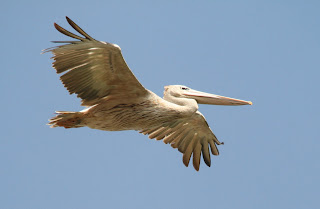Greyish Eagle-Owl
Later, I took some work down to Afex Camp on the White Nile in Juba - better than sitting in the office. Afex is perhaps the best place to watch birds by the river, but today was exceptional. The day had dawned grey, cloudy and wet, brightening in late morning. I arrived soon after midday and soon noticed plenty of birds of prey over the far bank. I guessed that they were mainly Yellow-billed Kites and Hooded Vultures. Mostly they were, soaring along with several tens of Marabou Storks, and 1-2 Wahlberg's Eagles, African White-backed Vultures, plus a Long-crested Eagle. Then I saw a 'buzzard': much more likely to be a European Honey-buzzard, I reckoned. It was indeed this species and soon I found more, all moving north beyond the east bank on the river, and none crossed to the near bank. At one point I saw 12 in the air together - and this a species for which there was only one record for South Sudan prior to last year, when Tom Jenner and I encountered several on migration at about the same time, also east of the White Nile.
European Honey-buzzards
Part of a flock of 12 European Honey-buzzards
The dull weather and a brisk north-easterly wind may have contrived to push the birds close to Juba. I wonder if they use the river as a migration guide and keep to the east bank.
I chatted to a couple, newly arrived in Juba. A nice coincidence as they were John and Lesley Henderson. Lesley commented on one of my recent blogs. Welcome to Juba.
Mass movement of White-winged Terns
A very quick estimate suggests that the flock in the photo immediately above may hold 1,500 birds. Other birds on the move included Woolly-necked Storks (a flock of six); Abdim's and Yellow-billed Storks; some bee-eaters that were mainly unidentified apart from a few Northern Carmines; and a few hirundines, probably mainly Sand Martins. Over the river were half a dozen Rock Pratincoles and some noisy Senegal Thick-knees.





































